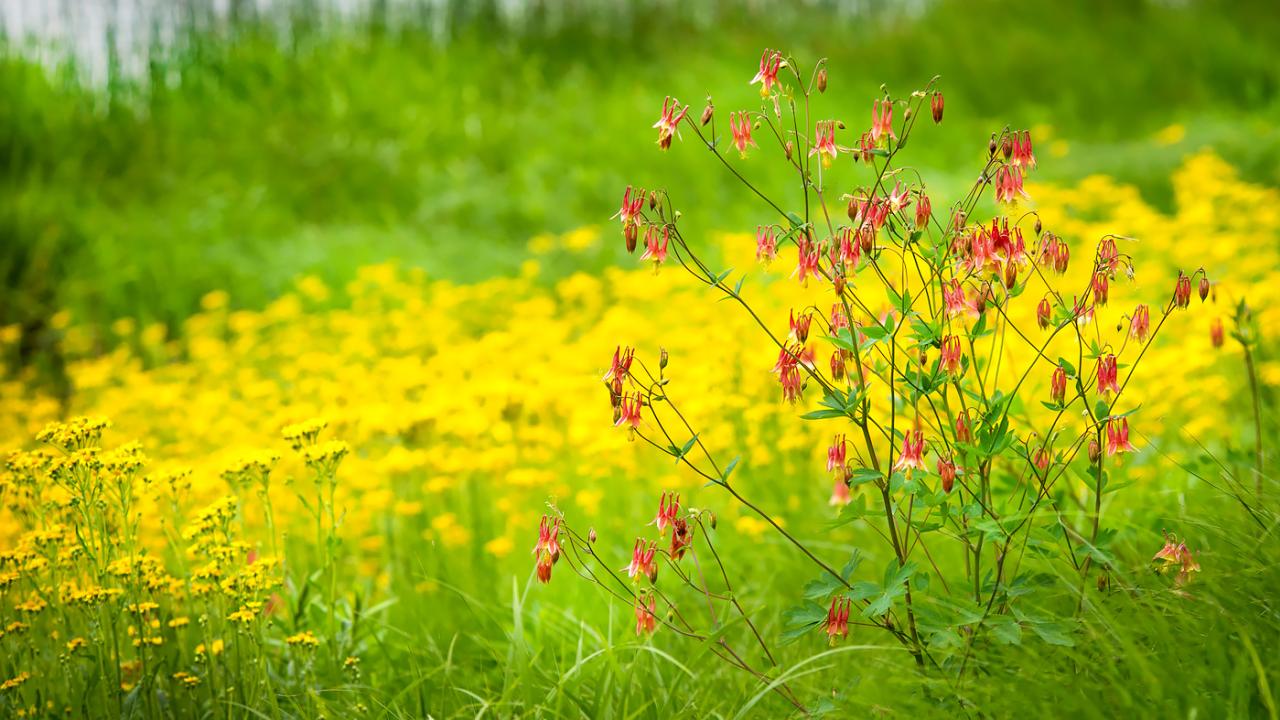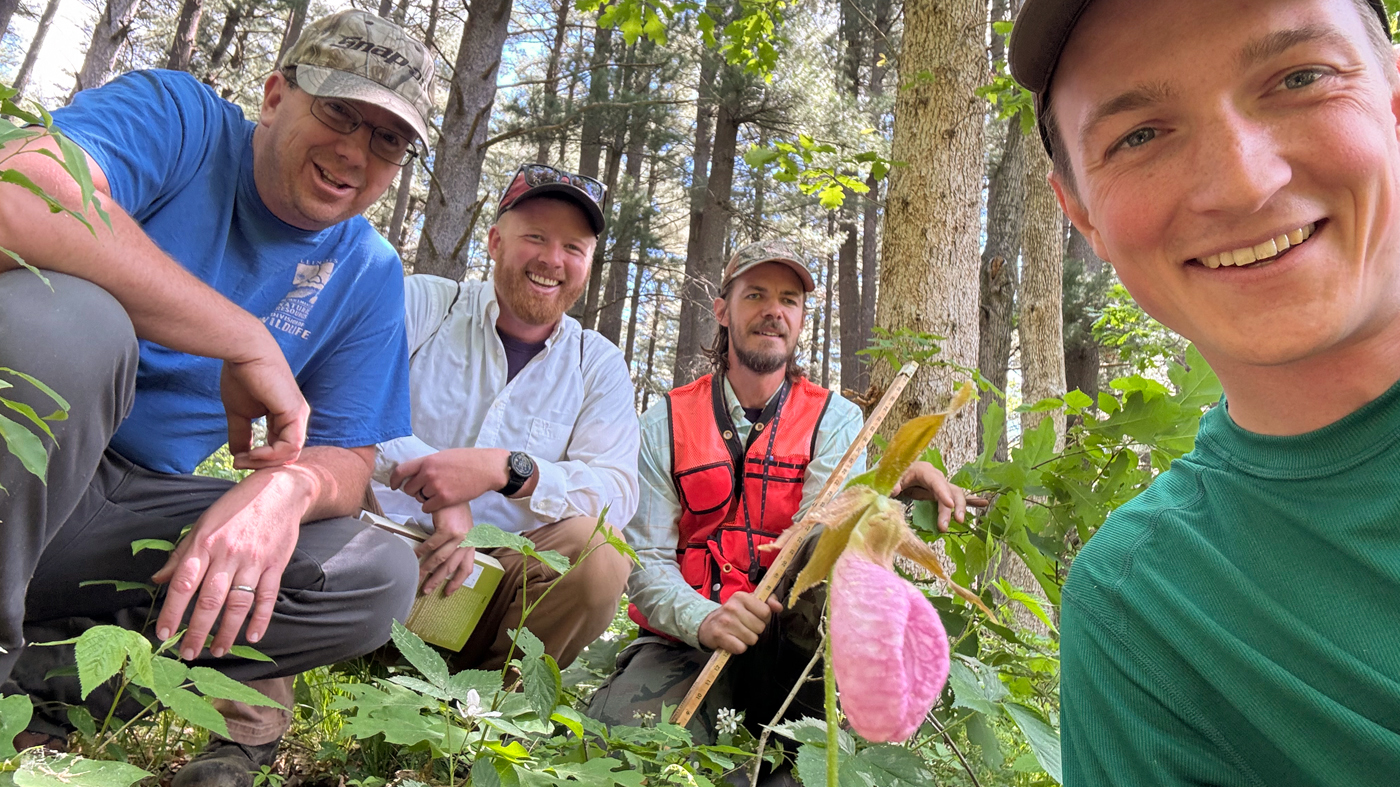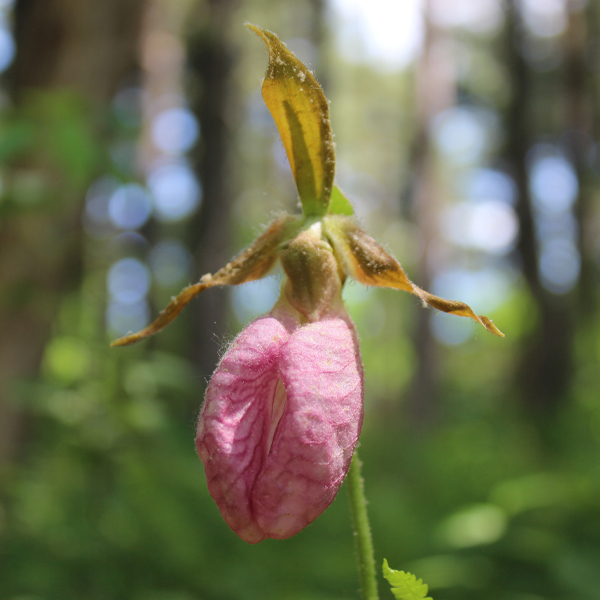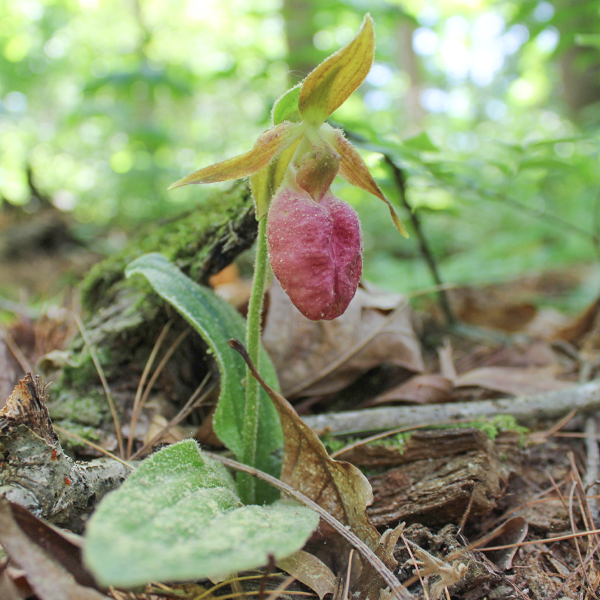

Plant Science &
Conservation
Garden Stories
Rare Orchid Rediscovered in Illinois
If a botanist shouts “Eureka!” in a forest, can you hear it?
Well, that’s exactly what happened—so to speak—when a team of botanists rediscovered the pink lady’s slipper (Cypripedium acaule), a dazzling orchid that has not been seen in Illinois since 1999.
That’s right. For a quarter century, conservationists had begun to accept that the species no longer existed here. That all changed in May when Grant Fessler, a botanist with the Chicago Botanic Garden’s Plants of Concern rare plant monitoring program, led a team to search for the elusive orchid known for its slipper-shaped blossom.
“Grant assembled a dream team, and it couldn’t have been a more important group of people who worked together to find it. These include the land managers who will return to manage and improve the habitat,” said Gretel Kiefer, program manager for Plants of Concern.
Fessler, coordinator of the northwest Illinois region for Plants of Concern, said, “This is really like uncovering a Holy Grail for Illinois botany. It’s a charismatic, beautiful plant. And I really wanted to find it.”

Team members from left to right: Jeff Horn, Illinois Department of Natural Resources, Kaleb Baker, Illinois Nature Preserves Commission, Daniel Pohl, Illinois Department of Natural Resources, Grant Fessler, Chicago Botanic Garden. Photo credit: Grant Fessler
It is a story worth hearing.
Fueled by curiosity and a hunger for discovery, Fessler partnered with Illinois Department of Natural Resources (IDNR) staff for a targeted trek to where the orchid was last seen.
The four men piled into an off-road vehicle to move over rough terrain, parked near a parcel of state land in northern Illinois, and began hiking slowly and methodically through the thicket.
“The UTV, a GPS mapping system, and our eyes were really the only necessary gear,” Fessler recalled. “All we needed to do was spot that telltale pink blossom.”
The area where the orchid had been mapped historically is quite small, so the team expected to conduct a thorough search in a day. After a couple hours with no sighting, they concluded that the species was indeed extinct in Illinois.
“Once we realized we weren’t going to find it, we kind of switched gears and decided to see if we could identify some other rare species that we knew to be in the general vicinity,” Fessler said. “So, we wandered a little outside of the original search area and set our sights on those species.”
As luck would have it, Jeff Horn, an IDNR biologist, suddenly pointed to something and called out, ‘What’s that pink dot over there?’ ” It was unmistakably the bright pink blossom they had almost given up on finding.
“It was one of those moments that didn’t feel real,” Fessler said. “We were giddy like we’d just met a celebrity or something.”
After a flurry of high fives, they took photos to document the exclusive discovery.
“The day we found the orchids was special,” recalled Horn. “I remember the exact moment I saw that pink lady’s slipper blossom in the foliage.”
The search then resumed to find and document additional pink lady’s slipper plants in the vicinity. Although its bloom time is typically late May to early June, the team knew there might be some that were not in bloom. The team located five more plants that were flowering, and 25 that were not.
“They are quite hard to spot if they're not flowering, but it’s not impossible,” Fessler said. “This species has two basal leaves that lie very close to the ground. They’re very hairy and do tend to stand out if you know what you’re looking for. We were keyed into these plant characteristics and that’s how we were able to find and record several plants that weren’t flowering.”
Some may wonder why we intervene to find a protected and rare plant. Why not let nature and evolution take their natural course?
“Natural selection is an evolutionary process over generations and generations,” Kiefer said. “Humans are an important part of that process. As a species, we have drastically reduced natural spaces, fragmented habitats, and disrupted the natural dynamics. It is our job to protect this part of the natural heritage of Illinois.”
To ensure that this population of pink lady’s slipper doesn’t easily disappear again, the team gathered important location, reproductive, and census data to guide future management. Land managers plan to remove invasive brush and add prescribed fire to improve and expand the orchid’s habitat at the site. Additional protective measures include regular monitoring and health assessments.
A week after the big discovery, Horn returned to the site to place cages over the plants that were flowering to protect them from deer—hopefully giving the orchid a fighting chance to go to seed and successfully reproduce.
“We’re absolutely thrilled to know that pink lady’s slipper has been found alive and well in Illinois and hope that with proper monitoring and management, this spectacular orchid species will continue to thrive here,” Fessler said.
Illinois is unique in that it lies at the intersection of many of North America’s botanical regions. Our flora includes plants from the cold boreal north, the moist deciduous forests of the east, the swamps and marshes of the southern coastal plain, and the arid western plains.
Because of the state’s special location, many species of flora exist at the outer reaches of their range here. This was the case for pink lady’s slipper, whose range had been known to extend only into secluded areas in the northern third of the state.
In 2024, Plants of Concern expanded into northwestern Illinois with funding from an anonymous donor and the IDNR. One of the priorities in this first year was to search for threatened and endangered plant species that had not been seen for many years, so, naturally, Cypripedium acaule was at the top of the list.




